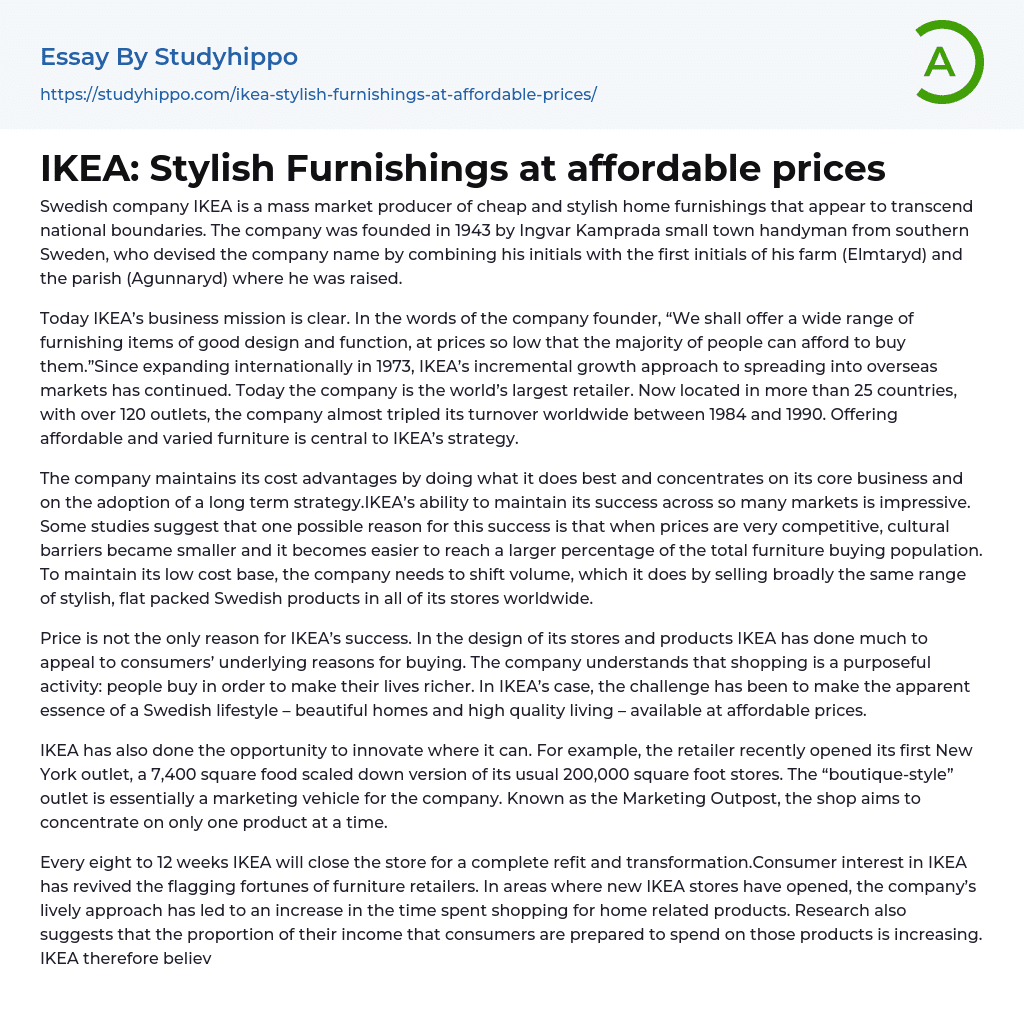

IKEA: Stylish Furnishings at affordable prices Essay Example
IKEA is a global manufacturer of affordable and fashionable household items that seem to defy cultural barriers. Its origins date back to 1943 when a local handyman from southern Sweden named Ingvar Kamprada established the company, naming it after his own initials, his farm (Elmtaryd), and the vicinity (Agunnaryd) in which he grew up.
IKEA's founder had a clear business mission of providing well-designed and functional furnishing items at affordable prices for the majority of people. Since 1973, IKEA has been expanding internationally with an incremental growth approach. As a result, it has become the world's largest retailer with over 120 outlets in more than 25 countries. Between 1984 and 1990, the company almost tripled its worldwide turnover. IKEA's strategy is centered around offering affordable and diverse furniture options.
The essence of IKEA's cost advantages is its focus on
...core business and long term strategy. The company's ability to succeed across various markets is notable. Some studies propose that the reason behind this success is the reduced influence of cultural barriers in highly competitive price scenarios, which makes it easier to reach a larger portion of furniture consumers. For IKEA, maintaining a low-cost base requires volume shifting, which is achieved by selling a consistent range of trendy Swedish flat-packed products in all its outlets worldwide.
Despite its affordability, IKEA's success cannot be attributed solely to its pricing strategy. The company has designed its stores and products with the intention of appealing to customers' motivations for shopping, recognizing that purchasing is a purposeful endeavor aimed at enhancing one's life. IKEA has specifically endeavored to make the attributes of a Swedish lifestyle, such as aesthetically pleasing
homes and superior living standards, accessible to consumers at reduced costs.
Innovation is a priority for IKEA, as demonstrated by their recent opening of a 7,400 square foot store in New York, which is significantly smaller than their usual 200,000 square foot stores. Named the Marketing Outpost, the boutique-style store focuses on highlighting one product at a time and serves as a marketing tool for the company.
IKEA plans to completely refit and transform its store every eight to 12 weeks, which has helped revive consumer interest in furniture retail. The company's dynamic approach has led to increased shopping time for home-related products in areas where new IKEA stores have opened. Research also suggests that consumers are willing to allocate a higher proportion of their income towards these products, as IKEA competes with other disposable income options like buying a new car or going on vacation, not just other furniture retailers.
Even though IKEA does not intentionally rely on demographic and psychographic variables to segment their customer base, their products appear to have a stronger appeal to individuals in their twenties and thirties. To expand their product line and reach other life cycle stages, the company is implementing a strategy of offering products tailored to families with teenagers and those whose children have moved out. While IKEA understands that consumers shop to enhance their lifestyles, the company also recognizes the importance of practicality. Consequently, consumers are more likely to visit retail outlets that are conveniently located and provide an enjoyable shopping experience.
One of the ways IKEA satisfies customers' needs is by situating its stores near highways and providing ample parking, toilets, childcare, and dining options. Additionally,
shoppers can explore a variety of furniture options displayed in actual room setups that blend costly, consequential purchases like sofas and carpets with inexpensive, low-stakes items such as lamps, decorations, and wall art.
- The price essays
- Adidas essays
- Amazon essays
- Apple essays
- Bmw essays
- British Airways essays
- Burger King essays
- Coca-Cola essays
- Company essays
- Costco essays
- Dell essays
- Ebay essays
- Enron essays
- Facebook essays
- Ford Motor Company essays
- Gap essays
- General Motors essays
- Google essays
- Honda essays
- Ibm essays
- Ikea essays
- Intel essays
- Iphone essays
- Johnson and Johnson essays
- Kellogg essays
- Key essays
- Kfc essays
- Mcdonald's essays
- Microsoft essays
- Myspace essays
- Nestle essays
- Netflix essays
- Nike essays
- Nokia essays
- Pepsi essays
- Pepsico essays
- Red Bull essays
- Ryanair essays
- Samsung essays
- Sony essays
- Southwest Airlines essays
- Starbucks essays
- Supermarket essays
- Tesco essays
- Toyota essays
- Twitter essays
- Volkswagen essays
- Walmart essays
- Outlet Stores essays
- Activity essays



